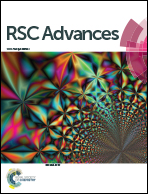Novel antibacterial application of photovoltaic Cu2SnS3 (CTS) nanoparticles†
Abstract
In the present work, Cu2SnS3 (CTS) nanoparticles were synthesized using the hot injection method. The structural, compositional and optical properties of the nanoparticles were evaluated using the X-ray diffraction (XRD), Raman spectroscopy, transmission electron microscopy (TEM) and UV-visible spectroscopy techniques, respectively. The XRD and Raman studies confirmed the formation of monoclinic CTS nanoparticles. The TEM and UV-visible spectroscopy studies indicated the formation of spherical nanoparticles in the size range of 10–12 nm with a band gap of 1.24 eV. The CTS nanoparticles were tested for antibacterial activity against Gram-positive (Staphylococcus aureus) and Gram-negative (Escherichia coli) bacteria strains by the agar-well diffusion method. The antibacterial activity of the nanoparticles was identified by determining the zone of inhibition (ZOI) and minimal inhibitor concentration (MIC). The study results reveal that the synthesized nanoparticles possessed excellent antibacterial activity against both bacterial strains, indicating the potential of the material for further research in biocidal applications. Finally, a plausible mechanism of antibacterial activity of the nanoparticles is proposed.



 Please wait while we load your content...
Please wait while we load your content...